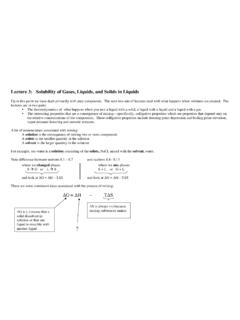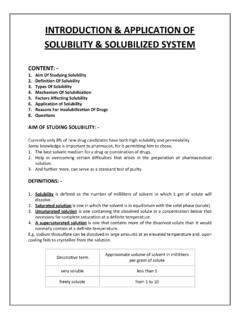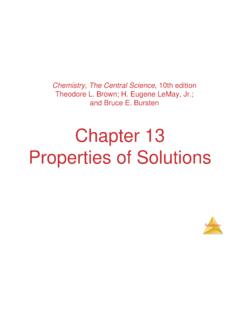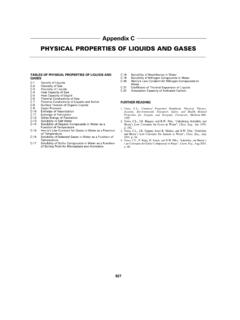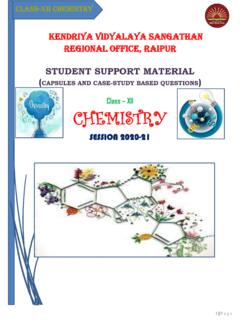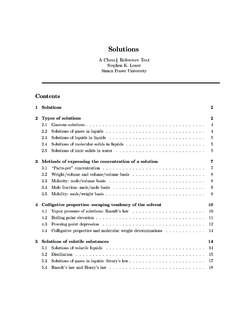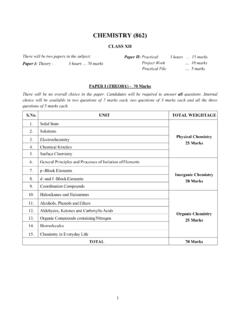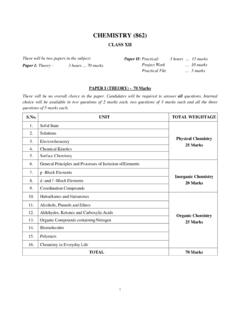Transcription of Factors that Affect the Rate of Dissolving and Solubility
1 Factors that Affect the Rate of Dissolving and Solubility Dissolving One very important property of a solution is the rate of Dissolving , or how quickly a solute dissolves in a solvent. When Dissolving occurs, there in NO CHEMICAL REACTION involved. Therefore, the solute and solvent can be separated using physical properties such as boiling points or filtration. The rate at which a solute dissolves depends on a number of Factors : i) Temperature Increasing temperature increases the kinetic energy (energy of motion) of the molecules, which increases the frequencies of collisions and the rate of Dissolving . ii) Agitation Stirring/shaking brings fresh solvent into contact with undissolved solute, increasing collisions and the rate of Dissolving . iii) Particle Size Crushing solute into smaller pieces increases the surface area that is in contact with solvent, thus increasing the rate of Dissolving . The Dissolving Process Whether or not a solute dissolves and to what extent depends on the forces of attraction between: Solute particles Solvent particles Solute and solvent particles When the forces of attraction between different particles in a mixture are stronger than the forces of attraction between like particles in the mixture, a solution forms.
2 The strength of each attraction influences the Solubility , or the amount of solute that dissolves in a solvent. The Dissolving process can be broken down into three key steps: 1. The forces holding the solute together must be broken (requires energy) Ionic compounds the forces holding the ions together must be broken Covalent molecules the forces holding molecules together must be broken 2. The intermolecular forces (between particles) holding the solvent together must be broken (requires energy) 3. Solute and solvent attract (release energy) and the molecules of solute fill in the spaces between solvent molecules. Note: Dissolving is more likely to occur if the energy required (steps 1 and 2) is less than the energy released (step 3). Polar and Non-Polar Substances In general, we can follow the rule of like dissolves like when trying to predict the Solubility of different particles. Ionic solutes and polar covalent solutes dissolve in polar solvents and non-polar solutes dissolve in non-polar solvents.
3 Remember, you can use the difference in electronegativities ( EN) to predict if a compound is ionic, polar or non-polar. There are a few possible forces that act between particles, which helps to explain the like dissolves like trend: Dipole-Dipole Attractions the attraction between the opposite partial charges on two different polar molecules. Ion-Dipole Attractions the attractive forces between an ion and a polar molecule. Ions posses a full charge and are therefore attracted to the partial charge on the polar molecules. When ions are present in an aqueous solution, each ion is hydrated. This means that water molecules surround the ion. Hydrated ions can conduct electricity and are referred to as electrolytes. Solubility Solubility describes the amount of solute that can be dissolved in a given amount of solvent under given conditions. A solute is described as soluble in a particular solvent if its Solubility is greater than 1 g per 100 mL.
4 A solute is described as insoluble in a particular solvent if its Solubility is less than g per 100 mL. Substances with Solubility between these limits are called slightly soluble. Factors affecting Solubility include: i) Molecular Size Small molecules tend to be more soluble than large ones. ii) Temperature Affects the Solubility of gases and solids in liquids. For gases in liquids: as temp Solubility For solids in liquids: as temp Solubility A Solubility curve (graph) describes how much solute can be dissolved in a given solvent at a certain temperature. iii) Pressure Affects the Solubility of gases in liquids. As pressure Solubility Concentration of Solutions Concentration is defined as the amount of solute per quantity of solvent. The concentration of a solution can be calculated. The approach for each calculation varies, depending on the type of solution. 1. Calculation as Mass/Volume (m/v) Percent Gives the mass of solute dissolved in a volume of solution, expressed as a percent.
5 Mass/Volume % = Examples: mL of distilled water is added to g of a powdered drug. The final volume of the solution is mL. Calculate the percent m/v and then express the drug concentration in g/100 mL. What mass of a drug is required to make a L solution if the recommended concentration is 2. Calculation as Mass/Mass (m/m) Percent Gives the mass of solute divided by the mass of solution, expressed as a percent. Mass/Mass % = Example: An aqueous solution of calcium chloride has a mass of g. The solvent was evaporated and the residue has a mass of g. Calculate the m/m % of calcium chloride in the solution. How many grams of calcium chloride would be present in a 100 g sample? 3. Concentration as Volume/Volume (v/v) Percent Gives the volume of solute divided by the volume of solution, expressed as a percent. Volume/Volume % = Example: Rubbing alcohol is sold as a 70% (v/v) solution.
6 What volume of alcohol is used to make 500 mL of rubbing alcohol? 4. Parts per Million (ppm) and Parts per Billion (ppb) Describes the concentration of very small quantities. Usually expressed in terms of mass/mass relationships. ppm = ppb = Note: Your final answer does not refer to the number of particles per million or billion, but rather the mass of solute compared to the mass of solution. Example: A shipment of oranges is returned if it contains more than 25 ppb of mould. A company received 20 000 kg of oranges. What is the maximum mass of mould allowed before the shipment should be sent back? Molar Concentration Molarity (C) is the number of moles of solute dissolved per litre of solvent. The equation we use to calculate molar concentration is: Where, C = molarity (mol/L or M) n = amount of solute in moles V = volume of solution in Litres Examples: What is the molar concentration of g of NaNO3 in mL of solution?
7 How many grams of potassium hydroxide will be required to prepare 650 mL of M solution? Preparing Solutions and Dilutions A standard (stock) solution is a solution with known concentration. There are 2 ways to prepare a solution: i. Dissolve a desired amount of solute in a set amount of solvent ii. Dilute a standard solution A useful tool in preparing solutions is a volumetric flask a pear-shaped glass with a flat bottom and a long neck. Volumetric flasks provide are very accurate tools for measuring volumes. To prepare a solution you should perform the following steps: 1. Determine the mass (g) of solute required to make the desired volume (L) and concentration (mol/L) of solution. 2. Measure out and dissolve the solute in approximately the total volume of solvent. 3. Raise the volume of solution to the desired total volume by adding more solvent. Diluting is a process that makes a solution that is less concentrated.
8 This can be done by: i. Adding more solvent (more common) ii. Removing solute Dilution Calculations: Step 1: Find the number of moles you need Step 2: Find the volume of stock solution you need Step 3: Top up with distilled water Example #1 How do you make a L solutions of NaCl with a concentration of M from a stock solution with a concentration of M? Alternatively we can perform dilution calculations using the following equation: Where, C1 = Molarity of stock solution V1 = Volume of stock solution C2 = Molarity of new solution V2 = Volume of new solution Lets try this equation to solve the previous example!!! Example #2 If mL of M sodium sulfate solution was used to prepare 200 mL of a dilute sodium sulfate solution, what is the new concentration made? Reactions in an Aqueous Solution- Ionic Equations When an ionic compound is placed in water, most will dissolve, which means they are soluble in water.
9 Some ionic compounds will remain as a solid and are insoluble. If an ionic compound dissolves in water, it means that the compound is temporarily splitting apart into its ions. This process is referred to as an ionic compound dissociating. This is NOT a chemical reaction and the ionic compound will readily re-crystallize when removed from the water source. Double displacement reactions occur in water, and are a direct result of ionic compounds dissociating into their ions. Recall that a double displacement reaction will only occur if water, gas or a precipitate forms. We can show the step-by-step process of a double displacement reaction by writing out an ionic equation. There are several different components to an ionic equation. Term Definition Total Ionic Equation Equation that illustrates all soluble ionic compounds in their ionic form Net Ionic Equation Equation that depicts only the ions that are involved in a chemical reaction Spectator Ion An ion that is present during a chemical reaction but does not participate in the reaction.
10 Example #1 Word Equation Silver nitrate reacts with sodium chloride Balanced Equation Total Ionic Equation Net Ionic Equation Spectator Ions Example #2 Word Equation Calcium bromide reacts with lithium chlorate Balanced Equation Total Ionic Equation Net Ionic Equation Spectator Ions Precipitate reactions can be used to generate a precipitation profile for known ions, which can be used to identify ions in solution. CO3-2 OH-1 SO4-2 Ca+2 Ba+2 Unknown ppt ppt ppt The unknown precipitation profile matches that of _____. Flow charts can also be used to illustrate what ions may be added to a solution containing many ions to allow for individual separation of ions by precipitation. When attempting to separate ions from a solution a piece of lab equipment called a centrifuge can be used. A centrifuge spins at very high speeds to separate different particles from each other based on their densities.

